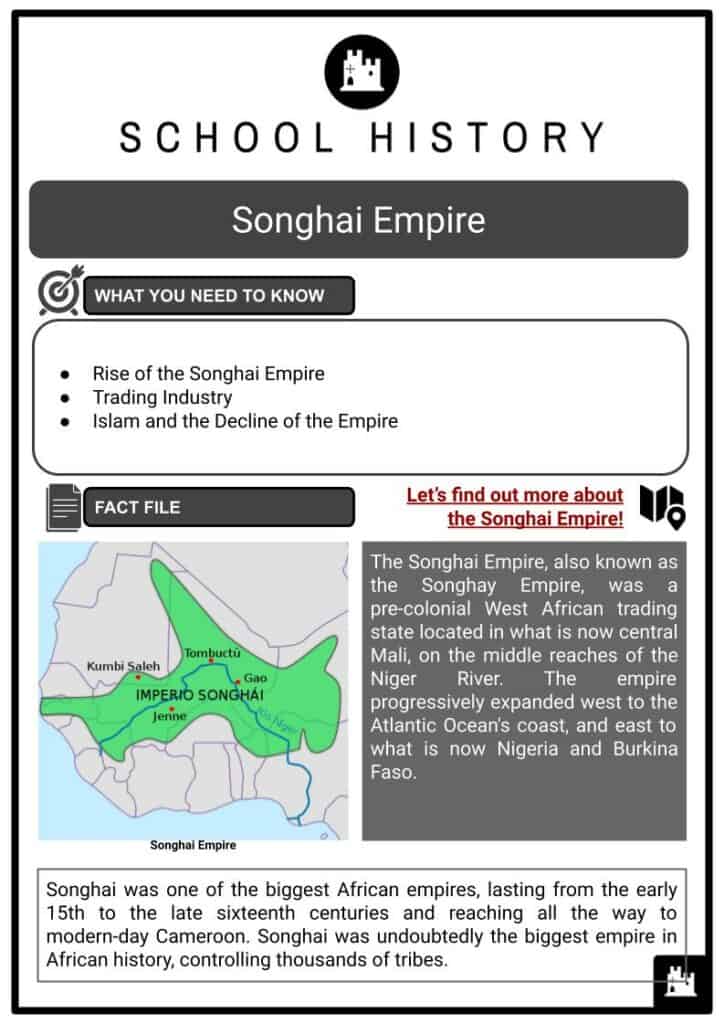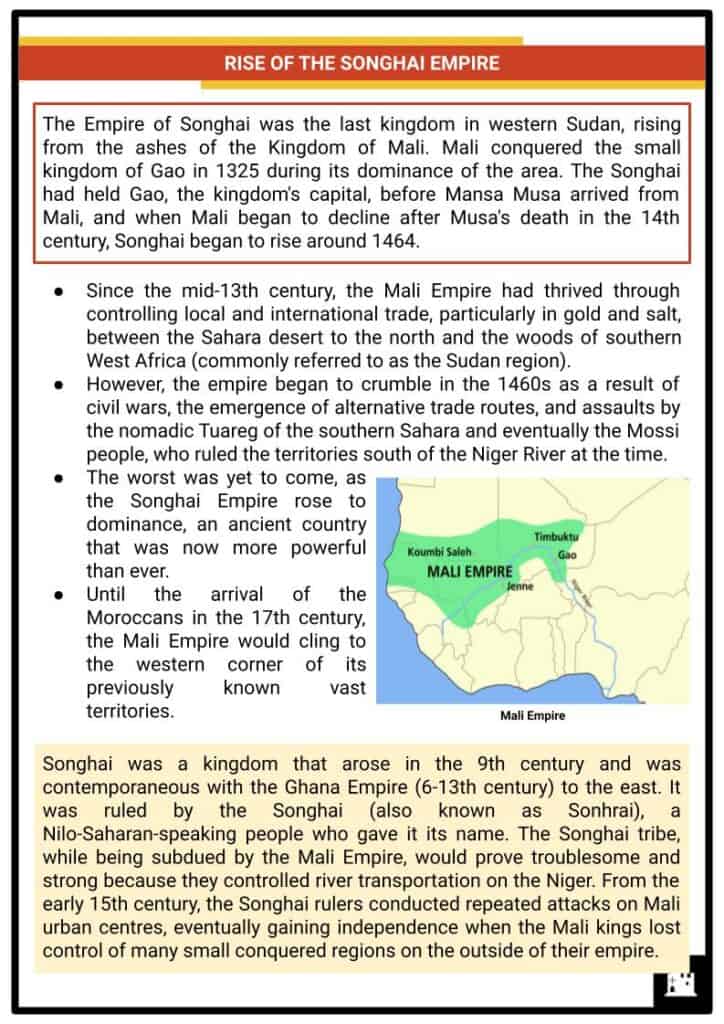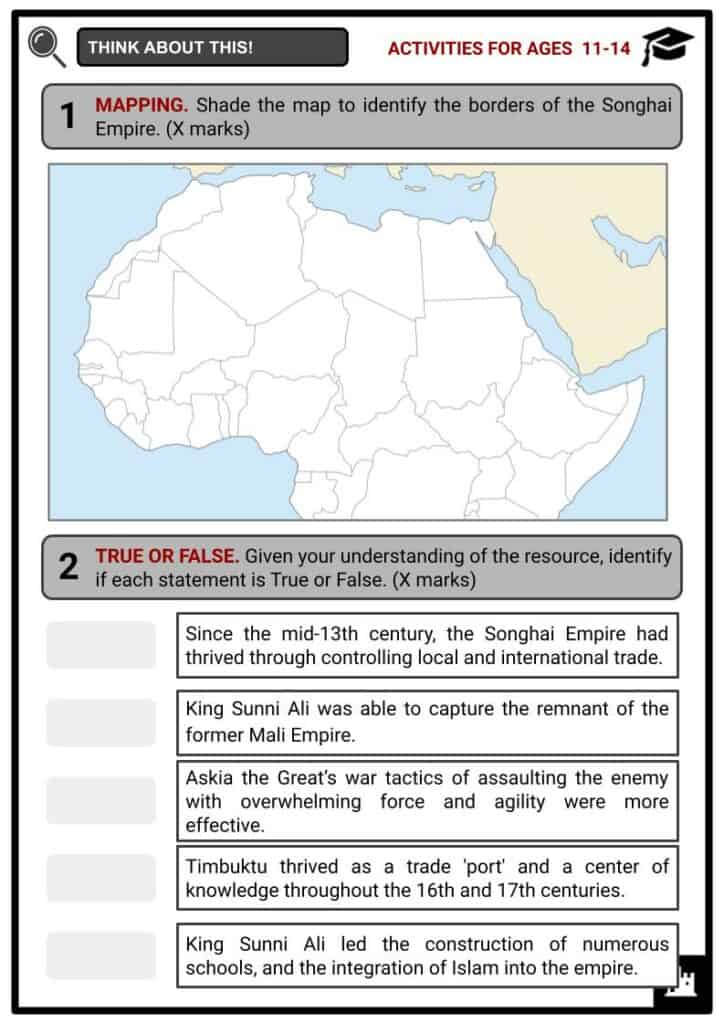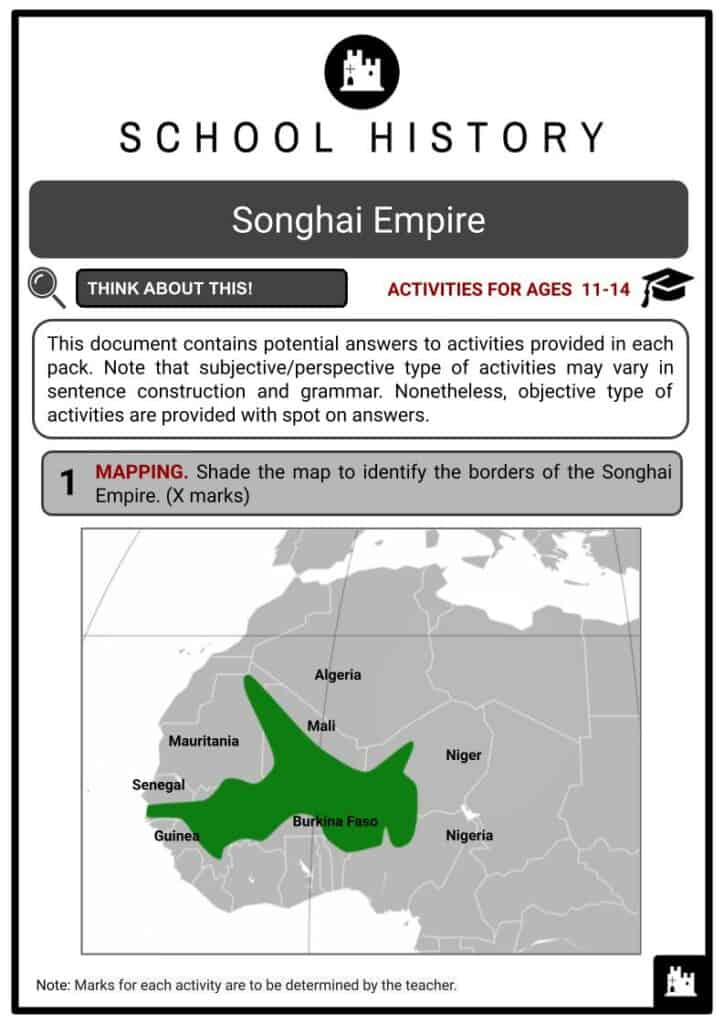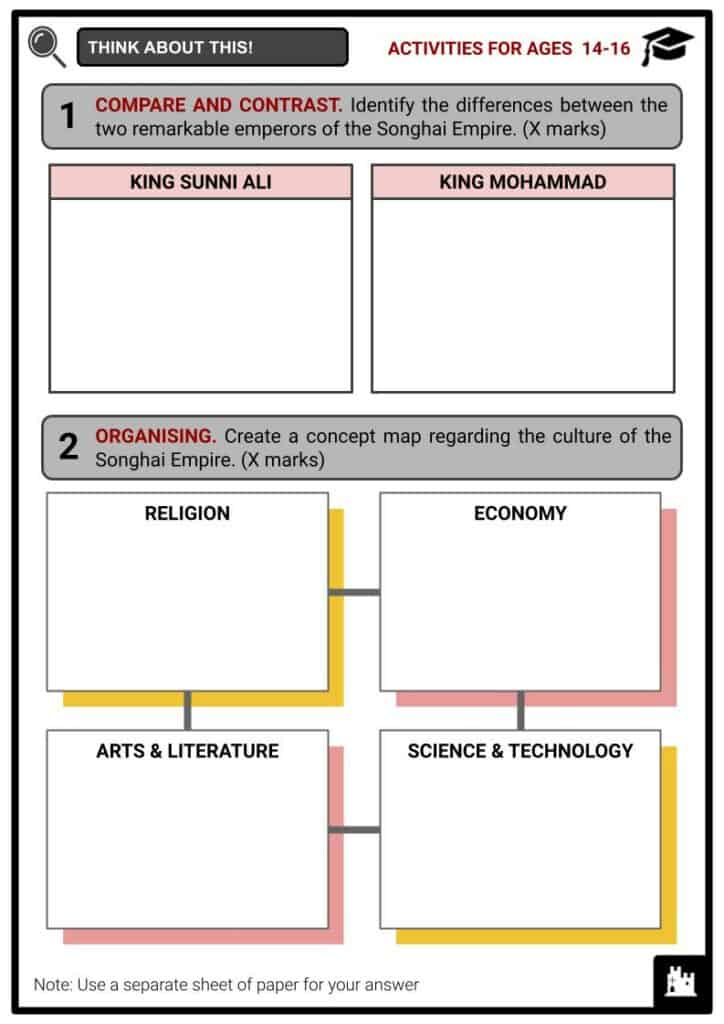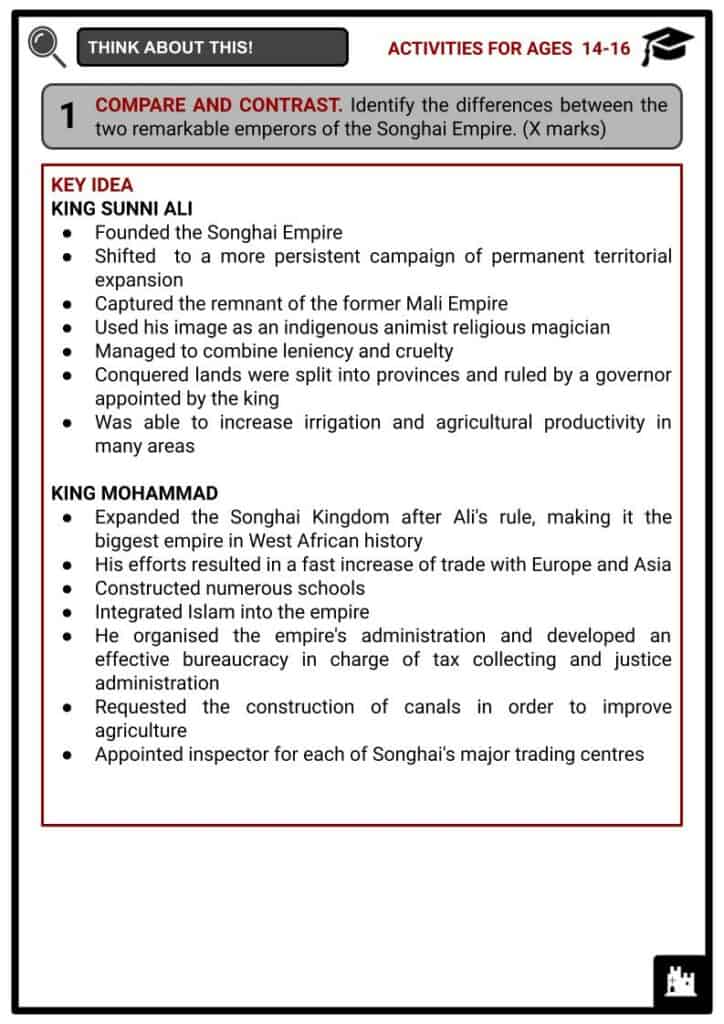Songhai Empire Worksheets
Do you want to save dozens of hours in time? Get your evenings and weekends back? Be able to teach about the Songhai Empire to your students?
Our worksheet bundle includes a fact file and printable worksheets and student activities. Perfect for both the classroom and homeschooling!
Summary
- Rise of the Songhai Empire
- Trading Industry
- Islam and the Decline of the Empire
Key Facts And Information
Let’s find out more about the Songhai Empire!
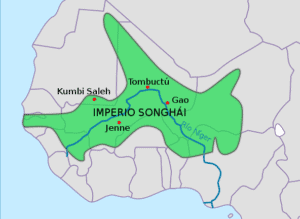
The Songhai Empire, also known as the Songhay Empire, was a pre-colonial West African trading state located in what is now central Mali, on the middle reaches of the Niger River. The empire progressively expanded west to the Atlantic Ocean's coast, and east to what is now Nigeria and Burkina Faso. Songhai was one of the biggest African empires, lasting from the early 15th to the late sixteenth centuries and reaching all the way to modern-day Cameroon. Songhai was undoubtedly the biggest empire in African history, controlling thousands of tribes.
RISE OF THE SONGHAI EMPIRE
- The Empire of Songhai was the last kingdom in western Sudan, rising from the ashes of the Kingdom of Mali. Mali conquered the small kingdom of Gao in 1325 during its dominance of the area. The Songhai had held Gao, the kingdom's capital, before Mansa Musa arrived from Mali, and when Mali began to decline after Musa's death in the 14th century, Songhai began to rise around 1464.
- Since the mid-13th century, the Mali Empire had thrived through controlling local and international trade, particularly in gold and salt, between the Sahara desert to the north and the woods of southern West Africa (commonly referred to as the Sudan region).
- However, the empire began to crumble in the 1460s as a result of civil wars, the emergence of alternative trade routes, and assaults by the nomadic Tuareg of the southern Sahara and eventually the Mossi people, who ruled the territories south of the Niger River at the time.
- The worst was yet to come, as the Songhai Empire rose to dominance, an ancient country that was now more powerful than ever.
- Until the arrival of the Moroccans in the 17th century, the Mali Empire would cling to the western corner of its previously known vast territories.
- Songhai was a kingdom that arose in the 9th century and was contemporaneous with the Ghana Empire (6-13th century) to the east. It was ruled by the Songhai (also known as Sonhrai), a Nilo-Saharan-speaking people who gave it its name. The Songhai tribe, while being subdued by the Mali Empire, would prove troublesome and strong because they controlled river transportation on the Niger. From the early 15th century, the Songhay rulers conducted repeated attacks on Mali urban centres, eventually gaining independence when the Mali kings lost control of many small conquered regions on the outside of their empire.
- Around 1468, King Sunni Ali (aka Sonni Ali Ber) shifted from the Songhai's usual approach of periodic raids on their opponents to a more persistent campaign of permanent territorial expansion. Sunni Ali was able to capture the remnant of the former Mali Empire with an army equipped with armoured cavalry and the sole naval fleet in North Africa, which he placed on the Niger River.
- To intimidate his foes, the Songhai king used his image as an indigenous animist religious magician.
- He also managed to combine leniency (for example, defeated soldiers were encouraged to join his army) and cruelty (infamously executing many of the particularly resistant Fulbe tribe).
- As a result, the king got the title "Sunni the Merciless."
- Sunni Ali's war tactics of assaulting the enemy with overwhelming force and agility were even more effective than these ideas.
- Conquered lands were split into provinces and ruled by a governor appointed by the king.
- Local leaders were extorted for tribute, hostages were taken, and political alliance marriages were made, but Sunni Ali built several dykes in the east, which increased irrigation and agricultural productivity in many areas.
TRADING INDUSTRY
- By 1469, the Songhai had taken control of Timbuktu, a major trade 'port' on the Niger River. The Mossi areas south of the Niger River bend were assaulted in 1471, and Djenne, another major trade centre in the region, was taken in 1473. Unfortunately for Sunni Ali, all of this additional land did not provide him access to the goldfields of West Africa's southern coast, which had made both Ghana and Mali prosperous. This was due to the fact that in 1471, a Portuguese vessel headed by Lisbon merchant Feno Gomes went across Africa's Atlantic coast and established a trading foothold in these goldfields (in modern Ghana).
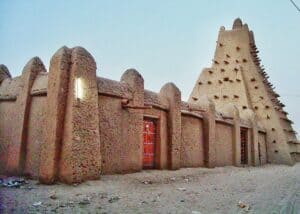
Timbuktu - With the development of the Mediterranean sea route, trans-Saharan camel caravans would face strong competition as the best means to transport commodities between North Africa and Europe.
- However, the Portuguese were not as successful in harnessing Africa's resources as they had intended.
- In any way, the Songhai dominated the Saharan caravan trade, which transported rocksalt and luxury items such as fine cloth, glassware, sugar, and horses to Sudan in exchange for gold, ivory, spices, kola nuts, skins, and slaves.
- Timbuktu thrived as a trade 'port' and a centre of knowledge throughout the 16th and 17th centuries, when the city had several mosques and 150-180 Koranic schools, with a population of over 100,000 in the mid-15th century.
- Trade centres, in particular, evolved into sophisticated urban centres with stone-built housing, huge public squares for regular marketplaces, and at least one mosque. A floating suburban population resided in mud and reed homes or tents around this centre. Meanwhile, rural communities remained entirely reliant on agriculture, though the prevalence of rural markets implies that there was often a food surplus. Famine was undoubtedly uncommon throughout the Songhay Empire's early half, and there are no accounts of peasant revolts.
- Askia the Great expanded the Songhai Kingdom after Ali's rule, making it the biggest empire in West African history. The Songhai Empire reached its peak under his rule, encompassing the Hausa states as far as Kano (modern-day Nigeria) and most of the area that had previously belonged to the Songhai empire in the west. His efforts resulted in a fast increase of trade with Europe and Asia, the construction of numerous schools, and the integration of Islam into the empire.
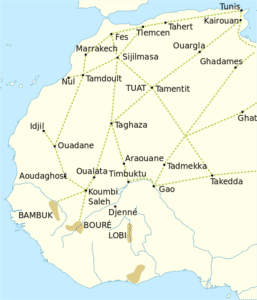
Trading Routes - The empire spread nearly from the Senegal River in the west to what is now central Mali in the east, and the capital at Gao had a population of 100,000 people. In addition, the valuable salt mines at Tagahaza in the north were part of the area. The Songhai Empire ruled practically the entire course of the Niger River, West Africa's trade superhighway, and the Songhai peoples were reduced to a small minority in a state that included the Mande, Fulbe, Mossi, and Tuareg.
- He organised the empire's administration and developed an effective bureaucracy in charge of tax collecting and justice administration, among other things. He also requested the construction of canals in order to improve agriculture and, as a result, trade. The introduction of weights and measures, as well as the appointment of an inspector for each of Songhai's major trading centres, were more significant than anything else he did for trade.
ISLAM AND THE DECLINE OF THE EMPIRE
- The Islamic religion, which had long been established in other Sudanese countries such as Ghana and Mali, had a tenuous presence in the Songhai Empire, at least at first. King Sunni Ali practiced Islamic traditions such as the Ramadan fast for political reasons alone (he also sacrificed animals to trees and supported pagan sorcerers) and was violently anti-Muslim, persecuting Muslims who posed a political danger without compassion. King Mohammad I, on the other hand, was a convert who even performed the hajj, or pilgrimage, to Mecca, where he was given the honourary title of Caliph of the Sudan.
- Mohammad enforced Islamic law on his people, appointing qadis (Islamic magistrates or judges) as heads of justice in Timbuktu, Djenne, and other cities, and enlisting the help of Mohammad al-Maghili, a North African, as his government counsellor.
- The latter's works would play a significant role in the Islamic reform movement that swept the area beginning in the 18th century.
- Undoubtedly, a largely Islamic urban elite evolved. There arose not just a class of affluent merchants, but also a class of religious academics whose writings not only investigated the ins and outs of their faith, but also created works on a wide range of topics from science to history.
- King Mohammad may have even attempted to establish Islam as the state religion, but, as in Songhay's predecessor states in the Sudan region, Islam was largely limited to the elite and urban populations, with rural communities and the majority of the population remaining loyal to their traditional animist beliefs. Spirits were considered to occupy various items in the later religion, particularly remarkable natural phenomena, trees, caves, and significant natural features.
- The two most powerful spirits were Harake Diko and Dongo, who were tied to the Niger River and thunderstorms, respectively, which is not unexpected considering the river's role in trade and rain in West Africa's dry savannah. These spirits, as well as others (particularly those of deceased ancestors), had to be kept happy at all times, thus food and wine were offered to them, and they were honoured with masked dances and rituals. Although it was more of a belief system than a formal religion, there were practicing priests, known as tierkei or sorcerers, who made it their job to keep bad spirits out of village affairs.
- From the final quarter of the 16th century, the Songhai Empire began to shrink along the borders, particularly in the west. This was due largely to a series of ineffective rulers and civil battles over succession rights that had afflicted the empire since King Mohammad's death in 1528. The empire was practically divided in two due to a dispute between Mohammad IV Bano and his brothers. Then came the final deathblow. In 1590 to 15911, Moroccan leader Ahmad al-Mansur al-Dhahabi, named "the Golden Conqueror," sent a small army of 4,000 men equipped with muskets to invade the empire.
- The Songhai force had 30,000 soldiers and 10,000 cavalries, but all they had were spears and arrows. The Moroccans won the battle as a result of this technological disadvantage, despite periodic but ineffective Songhai counter-offensives over the next few years. The Songhai treasury was captured, and the empire was merged into that of the Moroccans, with Timbuktu becoming a province inside it. The Songhay Empire, once the biggest in West Africa, had simply disintegrated and vanished from within. It would be the final great empire to rule West Africa since the sixth century.

